Juicer purchasing advice: how to choose the right product
- What You Need to Know
- Juicers process raw fruit and vegetables into fresh juice, which is not only richer in vitamins and healthier, but also cheaper than its industrially produced counterpart.
- Ready-made juices often contain additives such as sugar. Home-pressed juices, on the other hand, contain only natural, healthy ingredients.
- While slow juicers juice gently and centrifugal juicers work particularly quickly, steam juicers can produce large quantities at once.
- A large feed chute makes it unnecessary to laboriously chop the cut material beforehand – this saves time and work.
- For safe use, the juicer should be equipped with a locking mechanism, overheating protection and anti-slip feet.
The daily vitamin dose from your own kitchen
Finding it hard to fit the recommended five portions of fruit and vegetables into your daily routine? Freshly squeezed juices are healthy and taste delicious. What’s more, they make it easy for you to reach your daily fruit and vegetable allowance. What used to be done by hand is nowadays pressed by machine in no time at all. Although there are still mechanical juicers for small needs, larger quantities cannot be processed into juice with these handy devices – or at least only with a lot of time. Today, a variety of electric juicers with powerful motors are available that conjure up freshly squeezed juices in no time at all and help to meet daily nutritional needs.
Vitamin-rich and detoxifying
Juicers offer the ideal opportunity to prepare vitamin-rich treats in your own kitchen, just as you like. They are worthwhile for anyone who values a healthy lifestyle and a balanced diet. Fresh juices not only contain valuable nutrients and vital substances, but also important enzymes and plant substances that boost the immune system. They prevent vitamin and mineral deficiencies and help nip colds in the bud, especially in the winter months. In the morning, they provide energy for an optimal start to the day. Since juices are also particularly easy for the digestive system to digest, so-called juice fasting is an excellent way to shed excess pounds or actively detox.
The alternative to industrially produced juices
There are almost no limits to your creativity when it comes to juicing: While simple, manual juicers are only used for citrus fruits, electric juicers take on numerous types of fruit and vegetables. So you can decide for yourself which ingredients go into your juice. This also gives you control over how much sugar is included. Contrary to the usual advertising promises, ready-made juices often contain large amounts of sugar, but only a small amount of fruit. It is more like nectar – in other words, a fruit juice that has been cut with a lot of sugar and water. On top of that, the few nutrients and vitamins are destroyed in the course of preservation and replaced by additives.
Unlike their supermarket counterparts, you can enjoy the vitamin bombs from your own production without worrying, because you know exactly what they are made of. This is more time-consuming than the convenient alternative from the shops, but in terms of taste alone, a store-bought juice cannot compete with a fresh product from the juicer.
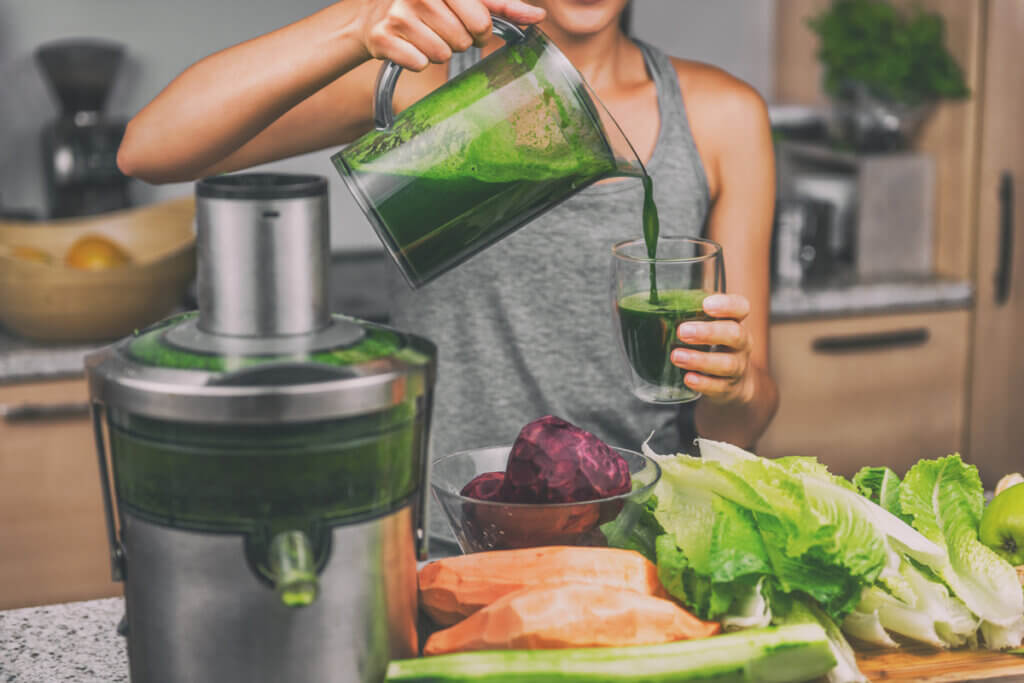
Whether it is for the glass of orange juice at breakfast or the annual purification cure: a juicer should not be missing in any well-equipped kitchen. While the first electric juicers were cumbersome to use, difficult to clean and downright deafeningly loud, modern, high-quality devices work quietly and efficiently. Many models can not only juice, but are also suitable for making plant milk, hummus or sorbet. To help you find your way through the wide selection on the market, which ranges from the good old citrus juicer to the steam juicer, we provide you with a decision-making aid.
An overview of juicer types
When looking for a juicer, we inevitably come across terms such as citrus press, slow juicer, centrifugal juicer and steam juicer. The various types of juicers differ fundamentally in terms of their mode of operation and thus also in the way they extract juice:
- Citrus juicers: by muscle power and lever action.
- Slow juicers: by pressing screws
- Centrifugal juicers: by centrifugal force
- Steam juicers: by steam
While manual citrus juicers are ideal for quickly and easily squeezing the morning vitamin kick, centrifugal juicers work with centrifugal force to grind the fruit or vegetables. Slow juicers use low speeds for maximum juice yield, while steam juicers use high temperatures and steam to produce long-lasting juices. The following table shows in condensed form which type of juicer is ideal for you:
| Buyer group | Ideal juicer |
|---|---|
| Occasional juice drinker | Juicer |
| Impatient saver | Centrifugal juicer |
| Vitamin fanatics and greens lovers | Slow juicers |
| Patience lovers | Steam juicers |
The different techniques therefore have an effect on how many nutrients are retained and how long the juice will keep. The following section will help you find the right model for your needs.
Juice extractors: Good things come to those who wait
The mechanical citrus juicer is the simplest and most cost-effective method of juicing. It is mainly used to extract juice from citrus fruits such as oranges or lemons. This is due to its simple design, which consists of a juice collection container and a ribbed pressing cone. When pressure is applied, the cone is used to squeeze a halved fruit. During this process, the small fruit bodies of the citrus fruits burst, so that the juice flows through a sieve into the collection container. Some models also have a filter sieve to separate the pulp from the juice.
The handy juicers take up hardly any space, are easy to handle and do not even need electricity. They are quickly ready for use at any time and produce juice of a high quality. Thanks to the low speed that users achieve through manual squeezing, no heat is generated, which means that the vitamins and enzymes are preserved. After pressing, the juice can be kept in the refrigerator for up to three days. However, the juice yield is lower than with electric devices. This makes the manual citrus juicer a practical kitchen aid for small juice needs, such as the glass of orange juice in the morning. However, the device would not get far with apples and carrots; slow juicers or centrifugal juicers are the better choice here.
For clean hands: pliers and lever presses
A special version of the citrus juicer is the so-called pincer press, which looks similar to a garlic press on the outside. The user places the halved fruit in the bowl and squeezes the pincers. While the seeds and pulp remain in the pincers, the juice flows out. Lever presses work according to a similar principle, but are much more bulky and are set up free-standing. Thanks to their lever mechanism, they can be operated without much effort. The juice goes directly into a glass placed underneath. This saves you from having sticky hands when pressing.
Electric juicers can produce larger quantities of juice in a very short time. They have a motor that rotates the pressing cone at the push of a button. The finished juice collects in the collection container, while the pomace remains in the appliance. Some models also dispense the juice directly into a glass. Although the appliance takes over the rotating movement in the electric version, you still have to hold the fruit yourself. At least the effort required is significantly reduced. Despite the higher speeds, this method also retains most of the vitamins. However, electric citrus juicers are only worthwhile if you want to drink fresh orange juice several times a week.
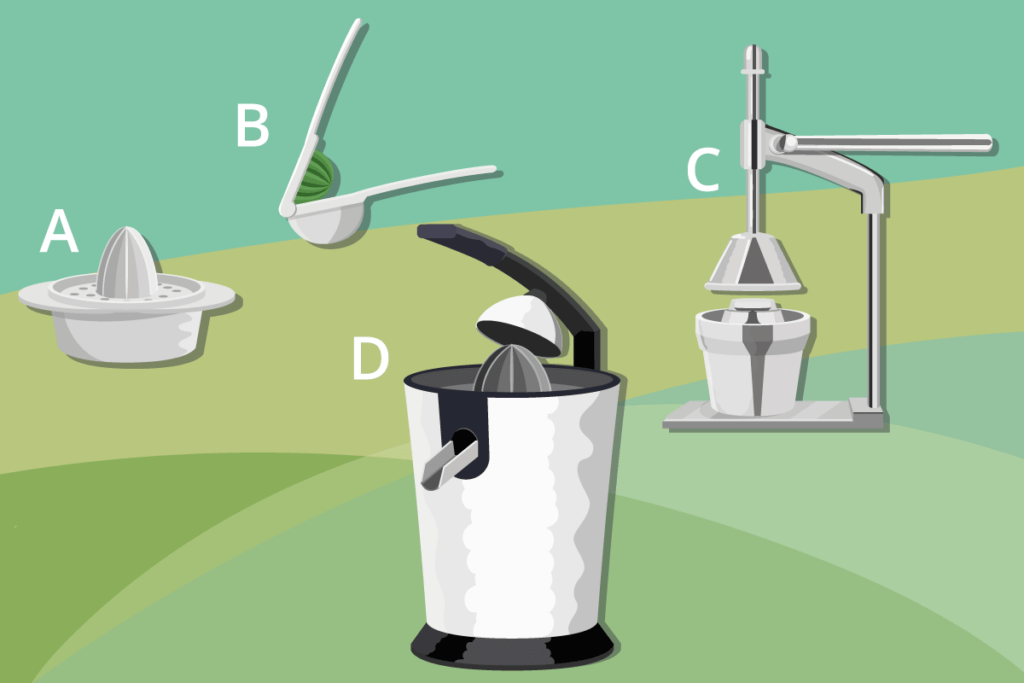
Centrifugal juicer: For those in a hurry to save money
Centrifugal juicers, also known as centrifugal juicers, bring a lot of momentum to the juicing process. The name already suggests that the fruit and vegetables are chopped by centrifugal force. Unlike citrus juicers, centrifugal juicers are not exclusively suitable for citrus fruits, but some models have problems with long-fibre ingredients such as wild herbs, grasses or tough root vegetables. They work a little more brutally than slow juicers, but have the advantage of juicing the pressed food within a few seconds.
The mode of operation
The high-speed juicers are composed of a feed chute, a sieve basket, a juice container and a pomace container. The lid has an opening into which you fill the fruit and vegetables. Compared to Slow Juicers, this chute is usually wider, so you can juice most ingredients whole. On the conical surface of the conically shaped sieve is a grater with numerous small, razor-sharp blades that grind the raw ingredients at up to 15,000 revolutions per minute. The tiny holes ensure a particularly effective separation of fruit flesh and juice.
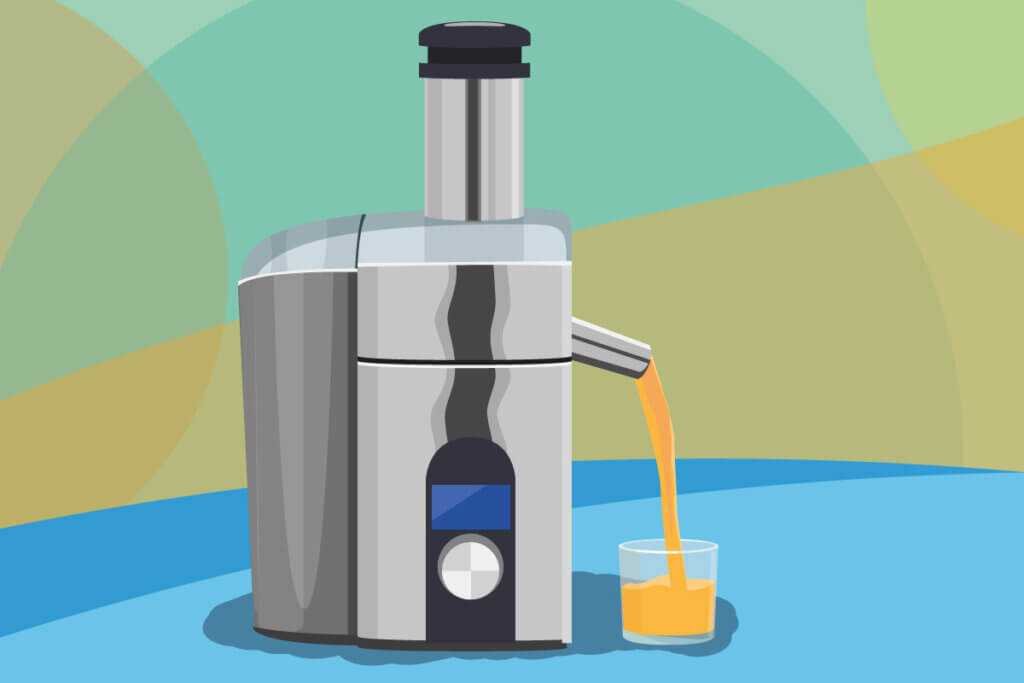
As the sieve rotates at a high speed, it spins the juice through the lateral conical surfaces into a juice bowl. From there, the ready-to-drink product passes through the outlet into the juice container. The residue collects in the integrated pomace container.
The disadvantages
The other side of the coin: The heat generated by the rotation speed destroys some valuable vitamins and enzymes. When the juice is spun out, a lot of oxygen also gets into the liquid, which promotes oxidation and limits the shelf life of the end product. The speed is accompanied not only by a higher operating volume, but also by increased foaming, which is not to everyone’s taste. The juice of a centrifugal juicer has a lower nutrient content and thus a lower quality, but this does not make the juice worthless. With the help of a graduated mechanism, consumers can also adjust the rotation speed to a certain extent to the respective pressed product.
In contrast to slow juicers, centrifugal juicers are optimised for stressed-out working people. The catch: the juices are only suitable for immediate consumption. However, if you can live with the loss of vitamins and prefer quick, uncomplicated juicing, a centrifugal juicer is a good choice.
How long can the juice be kept?
While ready-made juice can be stored without any problems and will keep for a while in the refrigerator even when opened, this is not possible with fresh juice from a centrifugal juicer. Since it is not heated to preserve it, it oxidises, which changes the taste and the composition of the nutrients. The juice should therefore either be consumed immediately or kept well sealed in the refrigerator for up to 48 hours. Caution: If it tastes “effervescent”, this is a sign that it has fermented.
Slow Juicer: Less is more
So-called slow juicers, which process a wide variety of fruits and vegetables, are suitable for more diverse uses. Even demanding pressed products such as fibre-rich vegetables, chlorophyll-containing products such as herbs and leafy vegetables, barley and wheat grass as well as nuts pose no problems for these devices. With the help of different sieve inserts, not only juices with different consistencies can be prepared, but also sorbet, nut puree and frozen yoghurt. This gives them quite a head start over centrifugal juicers.
The mode of operation
As their name suggests, slow juicers work particularly slowly and gently. In contrast to centrifugal juicers, the juice is not spun out at high speed, but pressed out at low speed. Slow juicers are therefore a little more gentle. The gentle technology causes hardly any friction and therefore only leads to a very low heat development, which means that a large part of the vitamins and nutrients are preserved. Thanks to the slow rotation speeds, a homogeneous liquid is produced without much foaming. This juice quality is also perceptible in terms of taste.
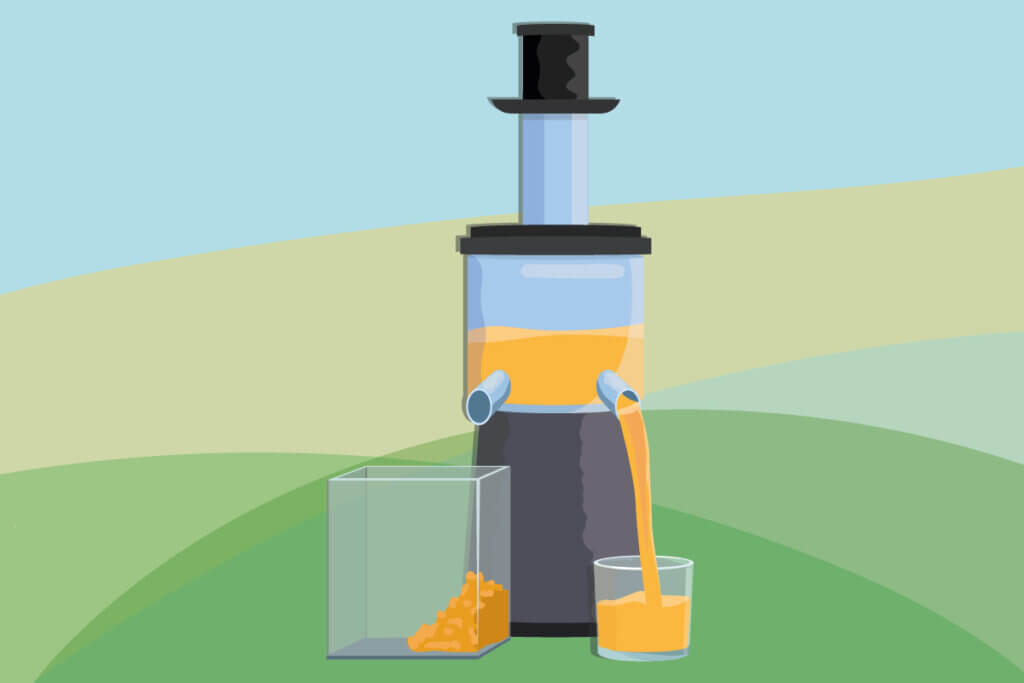
Very little oxygen gets into the juice, which means it oxidises more slowly – which means it has a longer shelf life. Another positive side effect: Since slow juicers work less brutally, they also produce less noise. As a result, they are much quieter in operation than centrifugal juicers.
The types
There are two different types of slow juicers, which differ in the position of their augers. In the vertical Slow Juicers, the pressing screw is installed vertically, which means that gravity helps to transport the pressed material downwards. In contrast, Slow Juicers with horizontally mounted pressing augers are transported solely by their rotational movement. If you often use green leafy vegetables for your juices, a horizontal juicer is more suitable for your purposes; otherwise, a vertical juicer will suffice.
In both cases, users feed the ingredients into the feed chute using the tamper. The motor-driven augers first break the ingredients into smaller pieces before crushing them into a pulp at less than 100 revolutions per minute. They then press the pulp through a sieve to achieve maximum juice yield. The solid components collect in the separate pomace container outside the machine. Unlike centrifugal juicers, users of a slow juicer do not have to scrape the fruit residues out of the machine.
The disadvantages
The disadvantage of this gentle preparation: Juice production takes considerably more time than with a centrifugal juicer. On the one hand, the longer time is due to the slow processing of the ingredients. On the other hand, the ingredients must be laboriously chopped in advance to fit through the narrow feed chute. If too many ingredients are filled in at once, this can lead to a blockage. Depending on the ingredients, the juicing process can take several minutes. If you are in a hurry in the morning, you should allow enough time or use another device such as an electric citrus juicer or a centrifugal juicer. However, if you are patient and want to produce juice that is particularly rich in vitamins, a slow juicer is the best choice.
Steam juicer: ideal for large quantities
Steam juicers work with steam. This is called hot juicing, while the other methods work as cold juicing. Basically, a steam juicer consists of three pots arranged one on top of the other – the filter basket, the collecting container with hose and the cooking pot – as well as a lid. The lowest element serves as a container for the water that is brought to a boil for steam production. As the water heats up, steam is created which rises to the top, penetrates the fruit cells and causes the pressed fruit to burst. The escaping juice is first filtered through a sieve before it runs into the collection container. The residue remains at the bottom of the ricer.
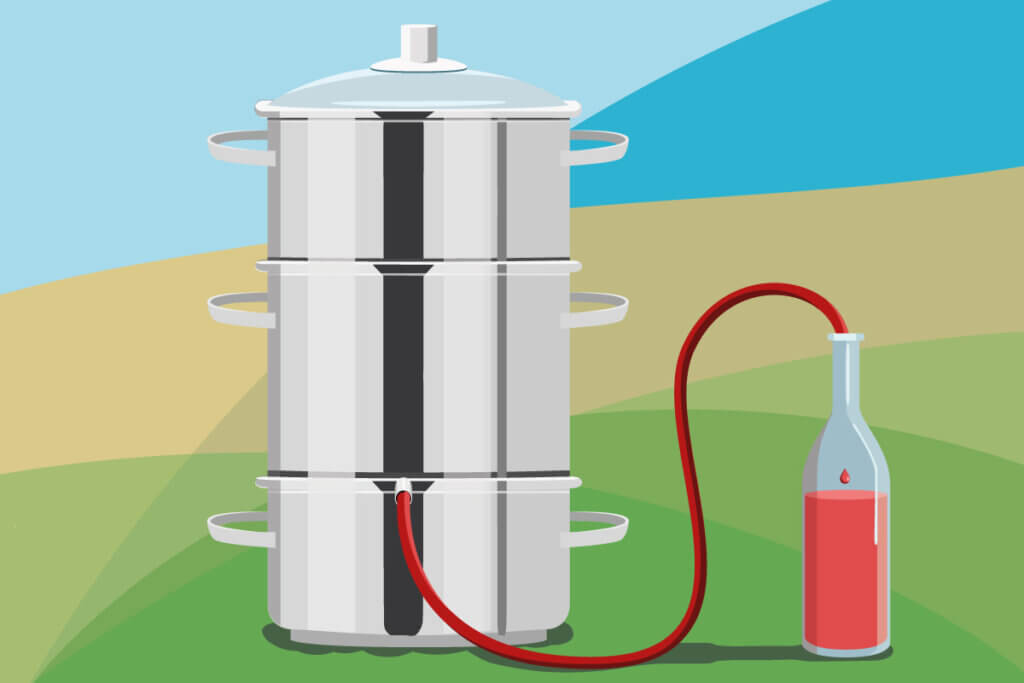
Since the entire process usually takes at least two hours, spontaneous juice enjoyment is not possible with a steam juicer. Instead, it is ideal for processing large quantities of fruit and vegetables. Although some vitamins and flavours are lost during the heating process, the products can be kept for several months without any problems.
Juicer or blender?
Basically, juicers and blenders are completely different kitchen appliances. Blenders process fruit with water to make a smoothie, depending on the desired consistency. They are easier to clean than juicers. However, less powerful blenders have problems with making fibrous smoothies. Juicers are the better choice for processing robust cellulose fibres of green leafy vegetables and herbs, which are hard to break down and difficult to digest unprocessed. They even process carrots, beetroot and wheatgrass effortlessly.
What matters when buying
Before deciding on the right juicer, you should consider how much storage space the appliance can take up, what ingredients you mainly want to process and what budget you are planning for. To ensure that you choose a product that you will be satisfied with in the long term, you should also consider in advance what demands you will place on the appliance and take factors such as juice yield and capacity into account accordingly. We have compiled the most important aspects for you.
Power, speed and volume: an inseparable trio?
The wattage of a juicer depends on the product type: While slow juicers are comparatively economical at around 150 to 200 watts, centrifugal juicers often have over 1,000 watts. The high wattage is necessary to achieve the desired result. The number of revolutions is directly related to the power. Here, the difference between the two types of machine is even more noticeable: Since slow juicers are not about power and speed, 80 to 100 revolutions per minute, for example, are quite sufficient. The manufacturers virtually undercut each other in their slowness. 80 revolutions per minute is a good guideline, but it should not be lower, as even a slow juicer needs a certain amount of momentum to juice hard pressed food.
Centrifugal juicers, on the other hand, work with centrifugal force at up to 15,000 revolutions per minute. This ensures particularly fast juicing of larger quantities. The rule here is: the more watts, the higher the juicer output and the higher the juice yield. However, the exception proves the rule, because the Klarstein Fruit Tornado, with just 400 watts, has a higher juice yield than the Braun J700 Multiquick 7 with a power of 1,000 watts and a rotation speed of 10,000 revolutions per minute.
Where there is juicing, there can be noise
Some manufacturers give noise emission values in decibels for their juicers. While some devices wake up the whole house during operation, others are barely audible. Due to their design, slow juicers are generally quieter at 50 to 70 decibels than centrifugal juicers, which produce up to 90 decibels. An exception is the Braun Multiquick with a comparatively quiet 50 to 60 decibels. This makes it even quieter than the Aicok Slow Juicer, which produces around 65 decibels. By way of comparison: a television set at room volume has about the same noise level.
Ultimately, the question of how much power the appliance needs also depends on the consistency of the ingredients primarily used. Do you primarily want to juice soft fruit? Then an entry-level appliance with about 300 watts is sufficient. Is it important to you that the juicer can chop any fruit and vegetables effortlessly? Then you should choose a device with about 1,000 watts. Centrifugal juicers also have an integrated speed regulator that allows users to choose whether they want to juice soft or hard fruit. However, a high power is basically a guide value for the motor reserves. Normally, a 300-watt juicer reaches its limits more quickly in continuous use than a 1,000-watt model.
Juice yield: Depends on the permissible operating time
Power and speed are by no means everything. It also depends on how long the motor lasts. That is why many manufacturers give a maximum operating time at a stretch as a safety note. For centrifugal juicers, this is 60 seconds on average; slow juicers, on the other hand, last 10 to 30 minutes. If you exceed this time frame, the appliance may overheat and the motor may be damaged. Of course, what is of particular interest here is how much juice is produced in this time. However, most manufacturers do not specify this value – with the exception of Philips, whose juicer produces two to three litres of juice in 60 seconds, according to the manufacturer.
Since centrifugal juicers work very finely, they often achieve a greater juice yield. They manage to juice even whole fruits and vegetables efficiently. The higher the juice yield, the better the juicer. The juice yield can also be recognised by the pomace, i.e. the drier the pomace, the more effective the juice yield. However, how much juice a device produces always depends on other factors, such as the condition of the ingredients used.
What are the benefits of a large-diameter feed chute?
The size of the feed opening determines the extent of the preparatory work, because: The larger the opening, the larger items will fit in uncut. Therefore, you should consider in advance what types of fruit and vegetables you juice most often and how much patience you have. While the pressed fruit must be cut into small pieces beforehand in the case of slow juicers, whose feed chute is often no larger than 4 or 5 centimetres, the usually larger feed chute of centrifugal juicers, with 7 to 8.5 centimetres, can even accommodate whole apples. Since hardly any preparatory work is required, a large-diameter feed chute makes handling particularly convenient. In addition, users can quickly add ingredients without interrupting the juicing process.
Advertising promises such as “wide mouth” or “XXL feed opening” are only of limited help in this context. The Aicok Wide-Mouth juicer, for example, with an opening width of 6.5 centimetres, has a much smaller chute than the Philips HR1921/20 with 8 centimetres or the Gastroback 40128 with 8.4 centimetres. A pleasing exception is the Kuvings Silent Juicepresso with an XXL feed opening of 7.5 centimetres, which is considerable, especially for a slow juicer. Ultimately, every centimetre counts here.
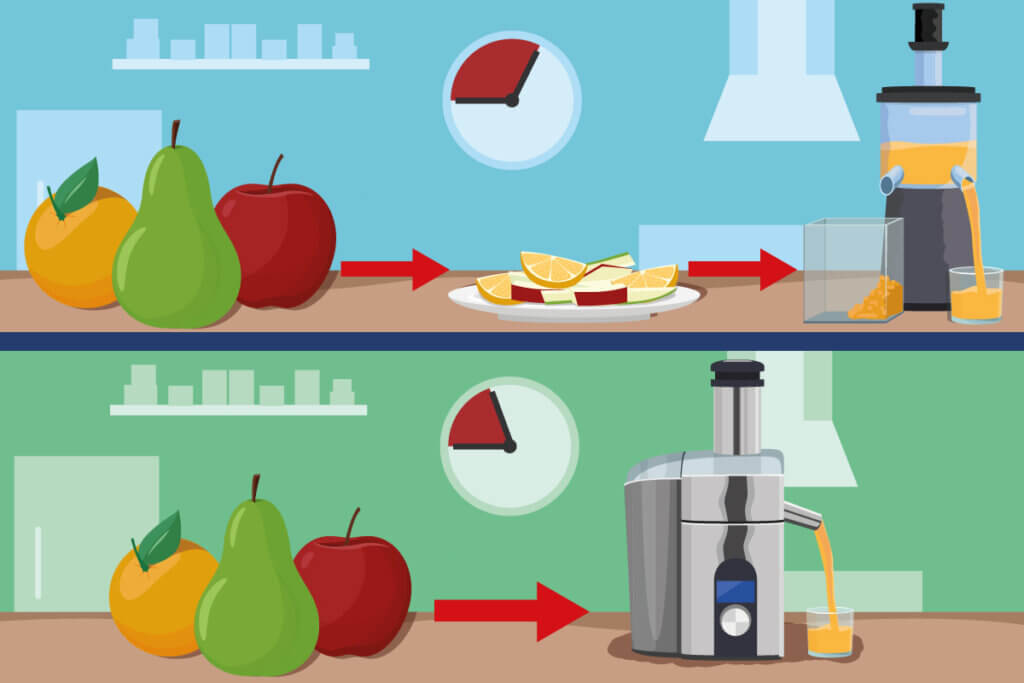
Juice and pomace containers for the big and small thirsts
When asking about the filling volume, you should consider how much juice you want to produce in one go. If you want to produce a lot of juice in a short time with your juicer, you should make sure that the appliance of your choice has a large capacity – this applies to both the juice and the pomace container. Families that need larger quantities of juice are better off with a model that holds several litres than, say, single households that drink one or two glasses a day at most.
The capacity depends mainly on the type of juicer:
- Citrus juicers: Since only half a fruit can be juiced at a time, they have the smallest capacity of about 0.75 litres. However, there is often a direct juice spout on the appliance, which means that the fresh juice ends up straight in the glass.
- Slow juicers and centrifugal juicers: Both can produce between 0.5 and 3 litres of juice per cycle, depending on the model.
- Steam juicers: Larger models can process up to 10 kilograms of fruit at once. The capacity is correspondingly large, holding between 3 and 7 litres of juice.
Ideally, the juicer comes with a scaled juice jug that connects seamlessly to the juice tap to avoid splashing. With a lid, you can store juice that has not been directly consumed in the refrigerator. While a large capacity has its advantages, it also tempts you to stockpile. However, as this is a fresh product, the longer it is stored, the lower the quality of the product. The pomace container should at least be large enough so that you do not have to empty it during a juicing process.
Safety interlock, overheating protection and anti-slip feet: The protective measures
Make sure your new juicer has a GS mark; it confirms that the appliance has been tested for safety. In addition, the juicer should be equipped with various safety mechanisms to eliminate the risk of injury. The following three are indispensable:
- Safety interlock: If the juicer is equipped with a safety system, it is only functional if all parts are properly assembled and the safety latch is engaged. Ideally, this also means that a motor stop kicks in as soon as the lid is opened, for example. This ensures that you do not come into contact with the rotating blades under any circumstances.
- Overheating protection: If the motor has to fight against particularly stubborn pressed material or is in operation for a long time at a stretch, it will get warm. Excessive heat build-up can cause considerable damage. Appliances with overheating protection register the heat generated and automatically cut off the power supply as soon as the temperature reaches a certain level. The juicer can then no longer be operated for a while to cool down. This means that users do not have to check themselves how long they have been using the appliance.
- Anti-slip feet: Stabilising suction feet made of rubber ensure a secure stand so that the juicer does not slip away from larger vibrations.
As a general rule, the longer the chute, the greater the distance between fingers and grater, i.e. the safer it is to refill. However, to be on the safe side, it is better to use the tamper to push in or refill the pressed product.
How much does a good juicer cost?
From the manual citrus juicer to the professional model: Juicers are available in all possible price ranges. The differences in cost are mainly due to the types of construction and the resulting varying performance. However, additional functions such as a drip stop, a foam separator or various strainer inserts also have a considerable influence on the price. Due to their simple design, manually operated juicers are the cheapest option. Manual citrus juicers are available for less than ten euros; they are thus a very inexpensive basic solution. Steam juicers are more expensive, costing between 25 and 150 euros. Centrifugal juicers are priced a little higher: while entry-level models start at around 30 euros, high-quality professional models can cost up to 300 euros. Slow juicers are the most expensive variant. You can expect to pay between 150 and 400 euros.
Although discounters also offer centrifugal juicers from time to time, we advise against supposed bargains for less than 50 euros, as they usually offer not only poor juicing performance but also poor durability. Ultimately, if you buy cheap, you buy twice. So if you want to enjoy your appliance for a long time, you should invest in quality.
For extra convenience – additional functions and extras
Some juicers have additional functions that make the operation and cleaning of the appliance more convenient for the user, depending on personal requirements. Although the following features are not a must, they offer a comprehensive range of options and thus increase convenience:
Fruit flesh regulation

Some centrifugal juicers allow you to individually adjust how finely the fruit and vegetables are pressed, so that the amount of pulp in the juice can be changed and adjusted to suit your personal taste. You can adjust the pulp content either with an adjusting screw or by using the various sieves supplied. Turn the knob to adjust the size of the holes in the juicer sieve. If the screw is set to “0”, a lot of pulp will end up in the juice; if it is at the maximum setting, you will get a pulp-free end product. If, on the other hand, your machine comes with separate sieve inserts, you have to insert them manually. Coarse sieves are suitable for puree-like drinks, while fine inserts are suitable for easy-to-drink juices.
Drip stop

Juicers often lose a few drops of juice after they are switched off. Some drip more, others less, but the result is the same: the work surface is damp and sticky. A drip stop, also called an anti-drip system, on the juice spout prevents puddles of juice by stopping the juice as soon as the container underneath is removed. This usually works manually. This means you either have to turn the juice spout away, flip it up or close it with a fitted cork. Juicer models that have this feature for a clean countertop include the Bosch MES25A0 as well as the Bosch MES3500 and the Philips HR1921/20.
Foam separator

This is where opinions differ: some like foam on their juice, others do not. Since many fruit juice lovers like to catch the juice directly in the glass, some machines have so-called foam separators, also called foam separators or foam scrapers. These special attachments are fitted either directly to the juice tap or to the juice collection container to retain the foam when pouring. This ensures that nothing but pure juice enters your glass. This means that although you can’t do anything about the foam formation itself, you can at least make sure that it remains in the container. Juicers with foam separators include the Gastroback Design Multi Juicer Digital and the Braun J700 Multiquick 7.
Reverse gear
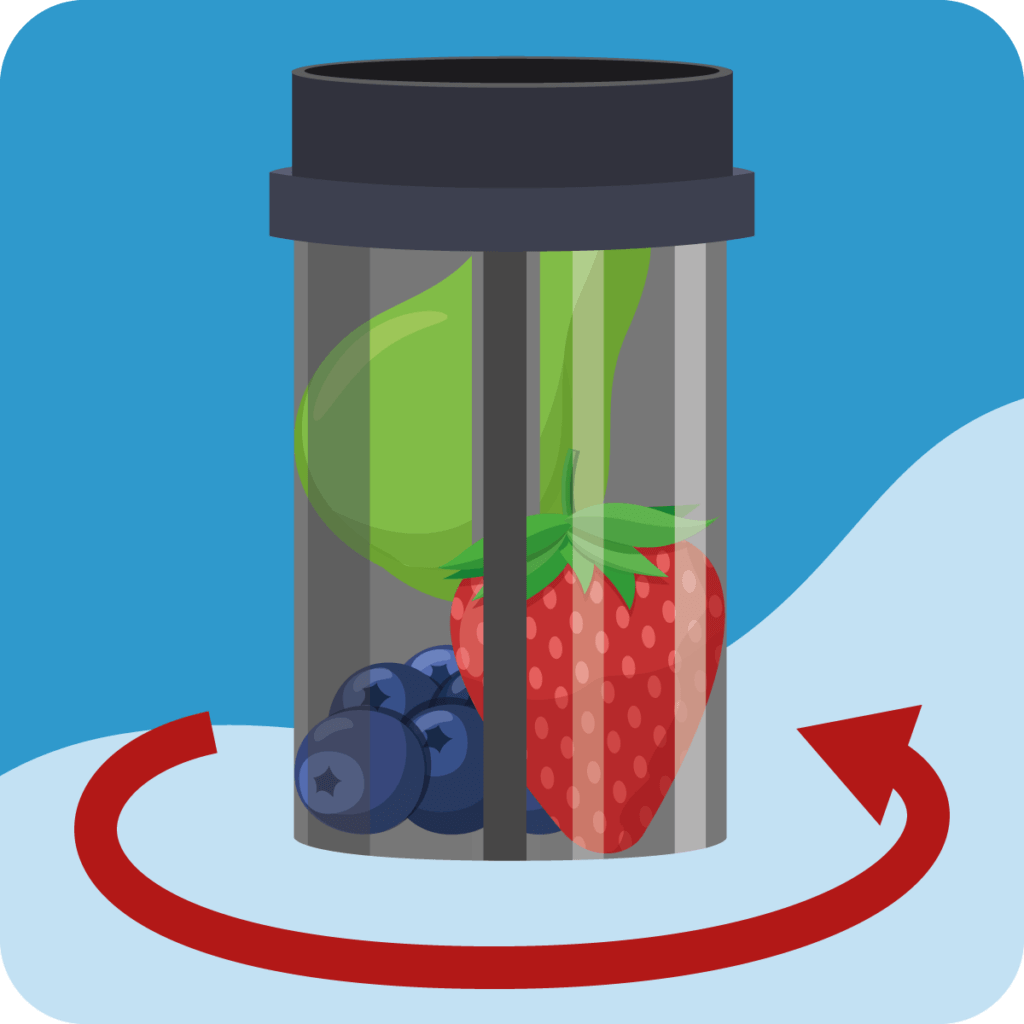
If you are impatient, it can quickly happen that you feed in too much pressed food at once or that a piece gets stuck and the juicer clogs up. With a reverse gear, also known as a reverse switch function, it is possible to clear any blockages in the shortest possible time. This is often a sensor that stops the motor directly when the juicer is overfilled and then automatically switches on the reserve function. Otherwise, you have to press a button manually for a few seconds. Without this feature, it would be necessary to disassemble the appliance with the juice inside. A stuck worktop would therefore be pre-programmed in this case.
Cable winder

If the juicer is not used every day, it makes sense to store it somewhere where it will not take up space. To prevent the cable from getting in the way or even being damaged during storage, many appliances have a cable winder. Thanks to this, the power cable disappears in or on the appliance. Some juicers have a cable storage compartment, usually on the underside of the appliance, which helps to keep potential cable tangles under control. An automatic cable rewind, on the other hand, ensures that the cable retracts into the appliance at the touch of a button, so that you can easily store your juicer.
Combination appliances for smoothies, ice cream and more
In the upper price segment, there are some juicers with various attachments that add numerous functions to your machine to give you even more options for culinary creations. With the combination devices, you can not only juice, but also blend and puree. They usually consist of a base station to which you attach the corresponding attachment, such as the citrus press, smoothie maker or blender. Some appliances even have an additional meat grinder attachment, a pasta maker or a grinder, which quickly turns them into a food processor. Other juicers offer the option of making sauces, purees or nut milks with the help of various graters and sieves. For example, the Kuvings Silent Juicepresso has an ice cream strainer that is perfect for frozen banana pieces to make “nicecream”.
Tips and hints for use
You have found your dream juicer and are now asking yourself which fruits and vegetables are suitable and which are less so? After each juicing process, we also recommend thorough care. But how exactly do I clean the juicer? Do I need certain accessories for this? You can find out exactly how to proceed in the following section. Finally, there is the question of the pomace, because this does not have to be simply wasted in the waste bin, but has a number of useful, tasty and ecologically sensible recycling options.
What can be put into which juicer?
With a juicer, you can not only make apple or orange juice, but also produce your own creative products from citrus fruits, pears, berries or carrots. Basically, juicers are capable of turning a wide variety of fruits and vegetables into juice, but not every model can process every type of pressed product satisfactorily. As already mentioned, some models are better suited for soft and others for hard ingredients. Centrifugal juicers in particular have their problems with soft ingredients. A look at the operating instructions usually clarifies what the machine is suitable for. Therefore, it is advisable to consider which fruit and vegetables are to be used primarily before buying.
The pressed material can be roughly divided into three categories:
- Chlorophyll-containing pressed material: These are mainly green vegetables such as chard, lettuce, spinach, sprouts, wheat grass and wild herbs, which are best juiced with a slow juicer.
- Hard pressed fruit: Centrifugal juicers are particularly suitable for processing fruit and vegetables with firm flesh, such as apples, pears, beetroot, carrots, kohlrabi or celery.
- Soft pressed fruit: Fruits and vegetables with soft pulp, including pineapples, berries, kiwis, tomatoes and grapes, are ideal for steam juicers. Citrus fruits such as oranges and lemons, on the other hand, require a citrus juicer.
Apart from that, there are products that are only conditionally suitable for juicing or for which you at least have to do a little more preparatory work:
Bananas: Since they contain a lot of starch, they hardly release any juice. The resulting banana pulp would clog the sieves.
- Apricots: Especially very ripe apricots have a high starch content. Although a liquid comes out, the remains would stick in the sieve or clog the outlet.
- Melon: Here you have to remove the skin; however, the seeds may remain.
- Beetroot: Peel the beetroot beforehand and clean the juicer immediately after the process so that it does not become permanently discoloured.
- Citrus fruits: Since the peel contains many allergens, at least allergy sufferers should always remove the peel before throwing citrus fruits into the juicer.
- Roots: Only roots that have a moist cut surface, such as ginger, are suitable for juicing.
- Stone fruit: With the exception of apricots, stone fruit has hardly any starch, so it can be juiced well depending on its degree of ripeness. However, you must remove the seeds from the fruit beforehand.
- Frozen fruit: Frozen fruit can only be juiced with a steam juicer. Other juicers would only produce sorbet.
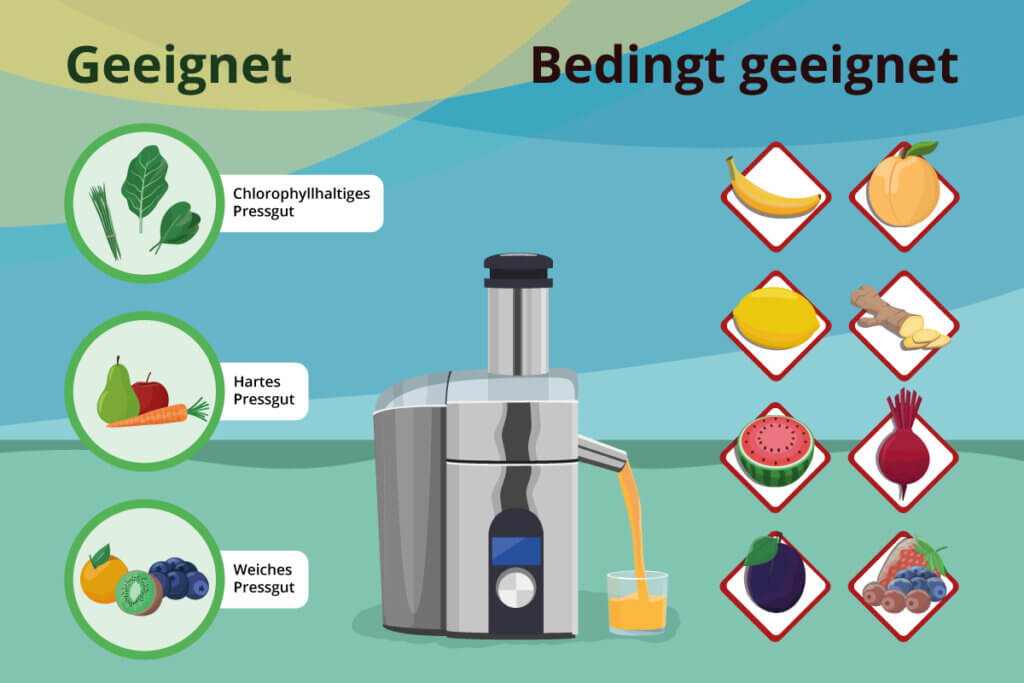
How do I proceed with cleaning?
Since food residues in kitchen appliances can lead to the formation of germs or mould, it is particularly important to clean the juicer thoroughly after each use. To ensure that you enjoy using your juicer frequently, the cleaning effort should be kept to a minimum. Whereas it used to take half an hour to clean a juicer, with a high-quality appliance you often only need a few minutes until it is clean. Ideally, rinse or at least soak the individual parts directly after each operation. Otherwise the residues, a mass of fruit sugar, fibres and moisture, will dry on the appliance, stick to it and gum up the components. This prolongs the cleaning process considerably. The sieves of centrifugal juicers in particular will quickly become clogged if you do not completely remove the residues.
With slow juicers, cleaning can be very time-consuming because of the many individual parts. Their feed chute is also quite narrow, so cleaning by hand is not easy. The separate pulp container, on the other hand, is more practical. Always rinse the container of a juicer with a brush under running water. Often the individual parts are dishwasher-safe, which of course makes the cleaning process much more convenient. However, this does not apply to the motor block or the fine sieve. For the latter, a soft plastic brush is recommended, which is sometimes included in the scope of delivery. A spatula end helps to remove the marc, and the sturdy bristles remove even the most stubborn dirt. In a pinch, a toothbrush can also help. However, only touch the edge of the grater so that you do not cut yourself on the sharp blades. Finally, wipe the appliance housing with a damp microfibre cloth and some washing-up liquid.
A pre-cleaning and self-cleaning function is even more convenient. The pre-cleaning ensures that even the last drop of juice is removed from the appliance. The self-cleaning mechanism rinses the appliance with water when the juice flap is closed and the motor is running. A special cleaning convenience, also known as “QuickClean”, is offered by some Philips juicers, for example. This means that you can clean the individual components quickly and effortlessly under running water.
How can the pomace be recycled?
After each juicing process, residues from the fruit and vegetables used, the so-called pomace, remain. Since it still contains many important vitamins and nutrients, it should not simply end up in the rubbish. But how can these leftovers be recycled? The following options are available:
- Bake a carrot cake from the leftover carrots.
- Dry the leftover beetroot to make crispy crackers.
- Use the leftover pumpkin and celery to prepare fibre-rich vegetable patties.
- Use the leftover cucumber for a face mask.
- Use the energy-rich pomace as heating fuel.
- Use the vitamin-rich mixed leftovers as feed for animals.
It is worth buying an automatic dehydrator to process the pomace into raw food quality. Ideally, consume it on the day of preparation so that the vitamins are preserved. If you don’t manage to use the pomace, you can also compost it and use it as fertiliser.
Juice or smoothie – which is healthier?
In the juicing process, the solid plant fibres, i.e. the dietary fibres, are separated from the juice. This relieves the intestines and ensures that the highest possible concentration of vital substances is absorbed more quickly by the body, which means an immediate energy boost. Since juices require hardly any digestive energy, they are especially recommended for a weak digestive system. However, dietary fibres are not just ballast for the intestines; on the contrary, they ensure that the fructose is metabolised more slowly. Unlike juice, in a smoothie the whole fruit is consumed, including the peel, pulp and seeds, which means we also absorb the digestive fibre that remains as pomace (all the solid components of the fruit) when juicing. Accordingly, the feeling of satiety lasts longer after consuming a smoothie.
Nevertheless, many people like a juice more than a smoothie because of its easy-to-drink consistency. A juice is much more of a thirst quencher, whereas a smoothie is almost a snack. What’s more, because juices are not only healthy but also delicious, they motivate even someone who can hardly be persuaded to consciously bite into a carrot to do something good for themselves with a little liquid fruit. Orange juices, for example, are rich in vitamin C, so that just two glasses are enough to cover the daily budget. Carrots contain beta-carotene for vision as well as iron, zinc, calcium, potassium and folic acid. In addition to vitamins B, C and E, cucumbers also contain many electrolytes that have a detoxifying and immune-strengthening effect. Green juices in particular have various positive effects, as they not only flush toxins out of the body and thus have a detoxifying effect, but are also particularly low in sugar.
The recommended daily intake of fruit and vegetables
The World Health Organisation recommends eating at least 400 grams of fruit and vegetables a day. This minimises the risk of fatal cardiovascular diseases. According to a recommendation by the German Nutrition Society, on the other hand, you should have five portions a day, or more precisely: three vegetable or salad portions and two fruit portions, for a total of 650 grams. You can easily consume large amounts of fruit and vegetables through juices, but since fruit contains energy-rich fructose, juices are actually a meal. Drinking juice will not fill you up, so you will be eating other meals as well, taking in more calories than you need. So stick to the recommended daily intake.

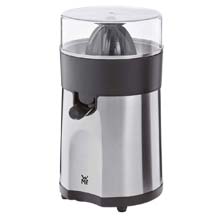
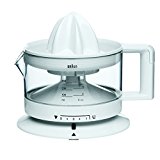
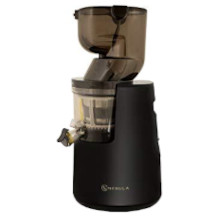
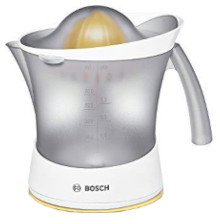
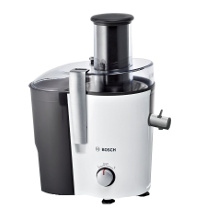
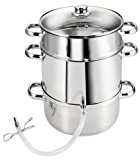


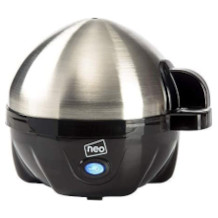

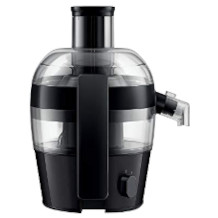
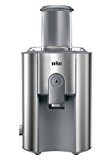
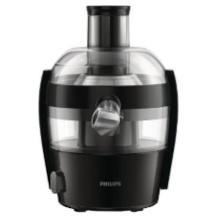
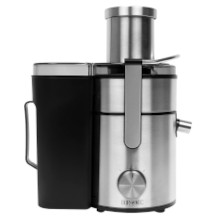
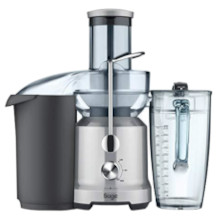

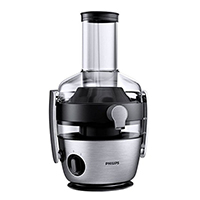
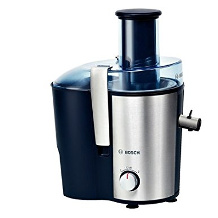
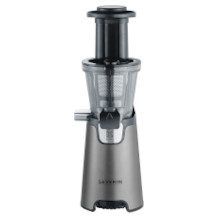
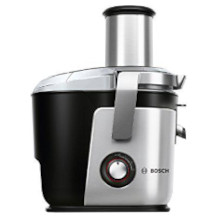
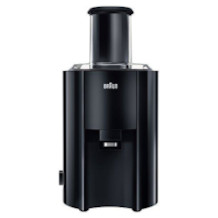
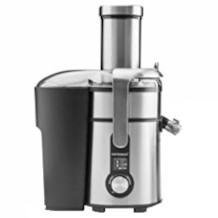
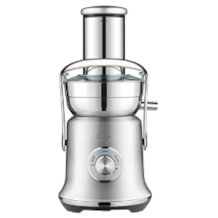
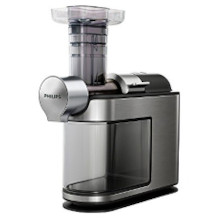
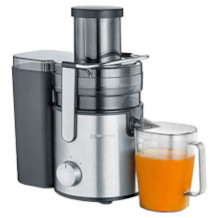
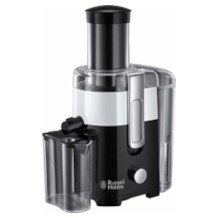
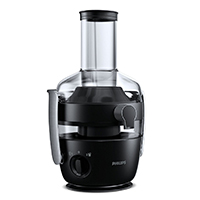
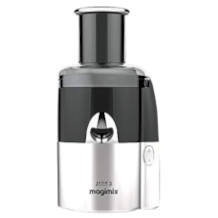

 1,268 reviews
1,268 reviews
